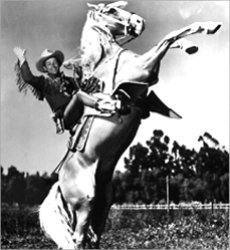Equine Training 101
Jennifer Johnston Hoggle
Many college-bound riders have nightmares about long hours of
studying behind a desk piled high with books. Long hours
previously spent at the barn are now occupied in front of a
computer or in the library. These students may not be aware that
their school is a member of the Intercolle-giate Horse Show
Association. The IHSA provides students with a unique college
experience, allowing them to participate in riding activities,
enjoy fellowship with other horse-loving team members, and gain
horsemanship experiences at challenging levels.
The goal of the IHSA is to provide college riders the opportunity
to ride and compete regardless of financial status. Horse showing
is an expensive sport, but the IHSA has narrowed the margin of
expense for college teams by requiring host schools to provide
equipment and horses. Students do not have to own a horse in
order to take part in IHSA activities. In fact, competitors are
not allowed to ride personal horses or use personal tack. The
host college provides horses and tack. The only requirement is
the riders must provide their own riding attire.
Some teams and teammates share clothing to save money. However,
it is better if riders have their own clothing so they can
practice in show boots and breeches and get used to the show
attire before going to the show.
Saddles are provided by the host college or, in some cases, by
the owner who loaned the horse to the IHSA for the day. Riders
are not permitted to bring their own saddles to shows. They also
may not adjust anything on a horse they may be riding, with the
exception of the stirrups. Only stewards, authorized college
personnel or horse owners can adjust, change or tighten equipment
for potential riders.
Intercollegiate competitions are much like any other competition,
but the IHSA has its own unique qualities. Riders and horses are
paired up based on a drawing. The rider has no time to warm up or
adapt to the new mount. Judges are not supposed to make decisions
based on how the horse and tack look. Only the rider's position
and the use of aids are being judged. Since the host college
provides all horses and tack, it is up to the rider to ask horses
to perform to the best of their abilities. Riders must adapt
their riding abilities and skills to many different types and
styles of horses with only a moment's notice. IHSA and rodeo
rough stock riders have a lot in common since, in both cases,
itís the luck of the draw.

When hosting a show, the college may own some of the horses as
well as borrow from friends and students. Some colleges have
their own string of horses, while other colleges do not own any
horses and students take private or semi-private lessons
off-campus at private facilities. The better scenario is for a
student to attend a college with an on-campus riding arena, barn
and college-owned horses. For example, Judson College owns its
own barn, arena and jump course. The majority of horses are
donations, with a few exceptions.
Generally speaking, IHSA horses are quarter horses, paints,
thoroughbreds, warmbloods, palominos or appaloosas. The IHSA
does not permit gaited horses, and Arabian horses must be
approved by show stewards before they can be used at shows.
The rider's position and ability is the main focus. Riders can be
asked to perform individual patterns or can be judged exclusively
on rail work. It is important to test and challenge
competitors' ability to ride patterns and transitions.
Competitors compete on different levels for IHSA points. Once a
certain number of points have been won, the rider moves to a
higher division. Levels range from Beginner Walk-Trot through the
Open Classes, which can also include reining or jumping
competition. Coaches select one rider from each level to be the
point rider for the school's team. The points earned by this
rider are used to calculate team points for regional, zone and
national qualifications, as well as rankings at the individual
shows. Regardless of their level of competition, riders gain
experience and encourage each other as a team.
The lowest level of competition is Beginner Walk-Trot. To be
eligible to compete in IHSA, a beginner must be able to ride
safely in any saddle on most any beginner-type horse and be able
to control the horse at the walk and trot. Most beginners can
show IHSA while in college if they really want to put the effort
and time into preparation.
The IHSA is a recognized member of the American Horse Show
Association (AHSA), which means the IHSA is actively involved
with the top professionals in the industry. Shows are judged by
AHSA and AQHA(American Quarter Horse Association) recognized judges.
There are now 29 regions and nine zones in the Intercollegiate
Horse Show Association, encompassing 48 states with 7,000 riders
and 300 teams. The average IHSA region includes 11 colleges, 225
total riders and competes in approximately eight horse shows per
year. For more information about IHSA, visit the web site at
http://www.ihsa.com .
Jennifer Johnston Hoggle is Director of Equine Science for Judson
College in Marion, AL.